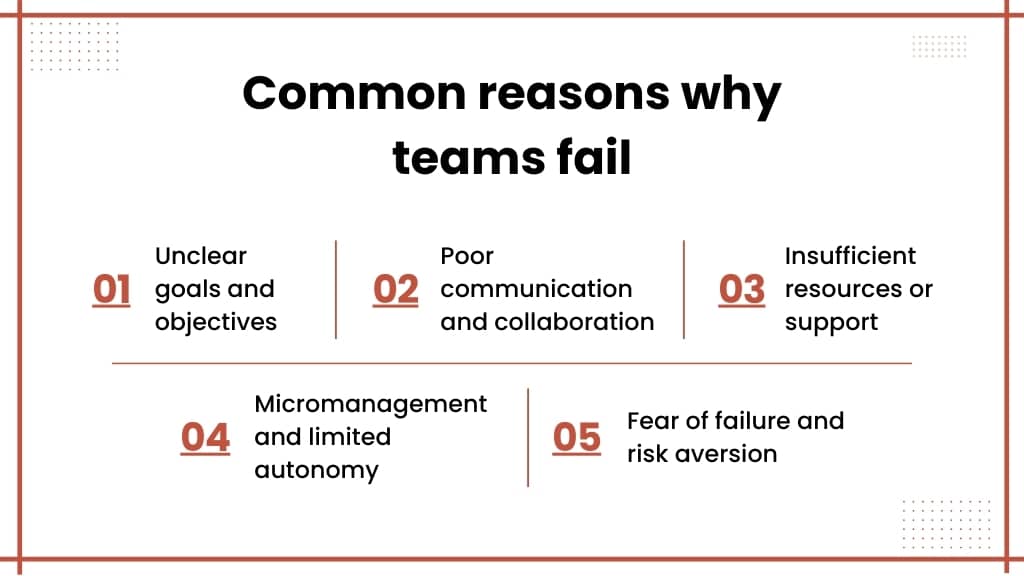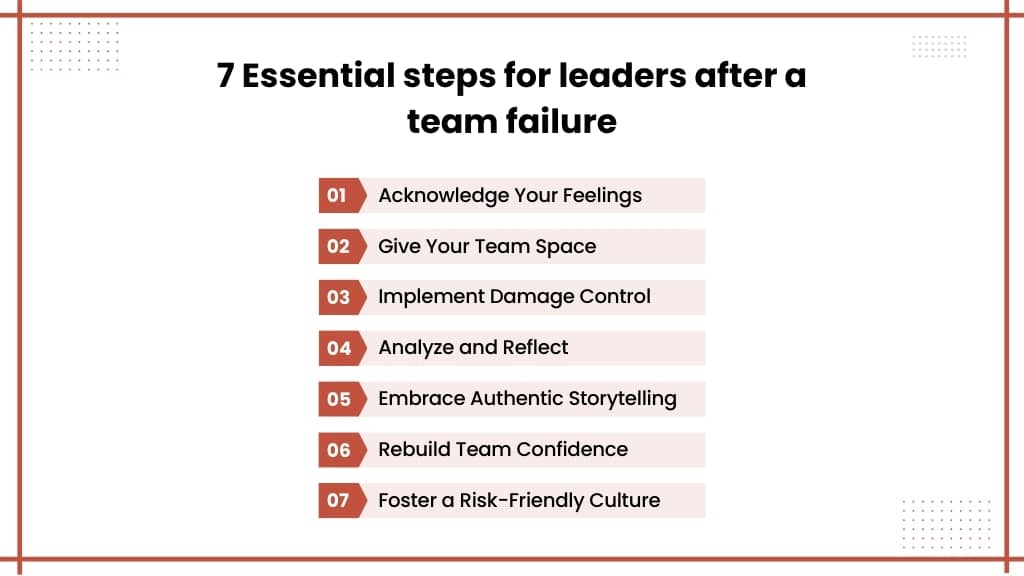Introduction
As a leader, it can be difficult for you to see your team struggling with failure. It’s not just about missing deadlines; such setbacks often lead to lowered morale, decreased productivity, and self-doubt among team members.
Failing to give the right support, failures can even cause your team to lose interest in their work. However, effective leadership can help turn these setbacks into valuable learning experiences.
Below, you will learn practical steps to help your team overcome failure and come back stronger. Also, you can build resilience and a positive attitude within your team.
Common reasons why teams fail
Before learning how to overcome a team failure, you need to find out why it fails in the first place. Here are some common reasons:

1. Lack of clear goals and objectives
Without clear goals or objectives, your team may feel directionless and frustrated, ultimately leads to confusion and inefficiency.
According to a survey, 50% of workers stated that clear goals significantly boost their motivation and sense of purpose.
When you know what you’re working towards, it’s easier to stay focused and driven. As a leader, it is your responsibility to set clear goals for your team, as these goals make them focused and target-oriented.
2. Poor communication and collaboration
Similar to a telephone game, when there are multiple middle people in a conversation, real messages get lost in between. One team member conveys a message to the next, and by the end, the message is completely different. It’s one of the biggest reasons for team failure.
Gartner’s research showed that 70% of a company’s mistakes are due to poor communication.
When your team members don’t communicate effectively, important information gets lost, misunderstood, or ignored. This lack of communication or collaboration leads to mistakes, missed deadlines, and overall poor performance. Open, honest, and frequent communication can hold your team together.
A communication tool like ProofHub can help you incorporate open communication within your team. These tools provide a centralized platform where all team members can share updates, share documents, receive feedback, and work collaboratively without juggling between various tools. It makes sure that everyone on your team stays on the same page.
3. Inadequate resources or support
If you don’t provide adequate resources and support to your team members, they struggle with their tasks. They can not perform well. In the end, this will impact their morale and self-confidence. They become frustrated and stressed.
It is your responsibility to have enough members in your team so that there is no burnout, and they have access to needed technology and training. Also, offer your support to them so that they can handle their tasks more efficiently.
Read more: How to deal with work stress and anxiety
4. Micromanagement or lack of autonomy
Gartner defines “micromanagement” as too much supervision and control over employees’ work and processes, with minimal delegation of tasks or decisions.
When leaders micromanage, they suppress their team’s creativity and initiative. Team members feel like they’re not trusted to do their jobs. As a result, there is disengagement and a lack of motivation within your team.
However, when teams are given autonomy, they feel empowered to innovate and take ownership of their work. This improves their performance and boosts morale.
5. Fear of failure and risk aversion
Teams that are afraid of making mistakes, never try anything new. This culture of fear is incredibly detrimental. When team members are scared to fail, they become risk-averse, avoiding innovative ideas and creative solutions. As a result, there is stagnation and missed opportunities.
A high-performance team culture encourages experimentation and views failures as learning and growth opportunities.
As a leader, you need to foster a supportive environment by promoting a growth mindset and celebrating both successes and failures as part of the learning process.
7 Steps leaders need to take after a team failure
It’s often harder to lead a team after a failure than it is to help one person. People coming into projects have different expectations, perspectives, levels of investment, and different things at stake.
Some people may be very resilient, and others might feel more hurt. All the things that individuals fall for – like making excuses and finding reasons – are even harder to deal with in a team, making the whole process more complex.
It doesn’t matter whether one person on your team is at fault or if everyone shares the responsibility, as a leader, it’s your job to help the entire group move on. Here are seven steps you can follow to do that.

1. Acknowledge your feelings
According to research, a leader’s feelings affect the whole team more than a team member’s.
So, while you don’t repress your emotions, you don’t want to get stuck in a negative mood either.
You need to do everything you can to move on from the disappointment. So that you can help your team deal with theirs. And, be genuine, don’t fake your emotions, or your team will see through you.
2. Give your team a bit of time and space
Once you acknowledge your feelings, wait for your team to handle theirs. It’s okay if they are disappointed or have negative feelings for a while.
Negative or neutral emotions help your team members improve their deductive reasoning. They can analyze their failure and process through it more effectively.
Acknowledge the disappointment by saying comments like “We’re feeling down” or “This is tough for us”. These comments make them believe they are not alone, you are with them. They can assess the critical situation they are in more clearly.
3. Institute damage control
When you and your team face a failure, step in and take control of the situation. The first thing you need to do is to find the reason behind the failure. So, talk to your team and provide support if they need it.
Team failure often leaves your team demoralized. Create a supportive environment for them. Admit that there is a setback but you and your team can learn from it.
4. Analyze and process what happened
You need to be direct and avoid using corporate language. You can’t say things like, “Let’s look on the bright side,” instead, acknowledge the issue directly, “We missed the deadline because we didn’t consider the time needed for each task.”
And most importantly, don’t blame anyone. Focus on identifying what went wrong, rather than pointing fingers. If there is a specific individual or a group at fault, confront them privately without attacking their character. You can say, “Here’s the mistake that was made. It doesn’t mean you’re a bad person, but we need to know why it happened and make sure it will not happen again”
When providing feedback to the entire group, make sure you don’t single anyone out. And the process is inclusive and fair. You can also set up an exercise where each team member shares constructive feedback to every other team member. This way everyone on the team will get personal and equitable feedback from their team members.
Read more: The impact of employee feedback on creating a positive workplace culture
5. Harness the power of authenticity and storytelling
You can help everyone learn from their experiences by sharing a mistake you’ve made in the past. It’s really impactful when a leader honestly talks about a time when they failed but it helped them grow in their career.
If you don’t want to share your own story, you can ask others in the group if they have a similar experience they’d like to share.
6. Rebuild team confidence
Acknowledge your team when they do well, even if it’s something small. This will motivate them. Also, remind them that they are capable and can do anything. You need to talk about the progress they’re making. This will create a positive and safe workspace.
Also, provide opportunities for training and learning. By doing so, your team will gain new skills and knowledge. As a result, they feel more confident and perform better.
When your team feels like they’re growing and getting support, they’ll get stronger. This makes them believe that they are ready to deal with tough situations. Your support and commitment can help them go through failure and succeed in the future.
7. Cultivate a risk-friendly environment
A risk-friendly environment can help your team overcome any failure. Let them know that it’s okay to take calculated risks as sometimes they can be rewarding.
When your team knows that failure is just a part of the learning process, they will become more open to trying new things. Make them learn from their mistakes at work. Each misstep can help your team improve their processes and strategies.
This kind of mindset helps your team grow and builds resilience and confidence within your team. As a supportive leader, you can turn setbacks into opportunities for success.
Conclusion
In a nutshell, it is your responsibility to back up your team after a failure. Instead of seeing your team struggling with failure as a bad thing, a leader needs to use it as an opportunity for their team to learn and grow.
You can help your team learn from what went wrong, and support and motivate them to overcome the failures. Your supportive leadership can turn failure into a stepping stone. This will help your team become more resilient and confident.
For more such useful information, keep reading-




























No Comments